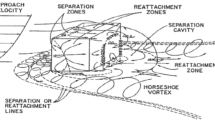Abstract
The objective of this study is to obtain better understanding of the flow over two tandemly positioned bluff bodies in close enough proximity to strongly interact with each other. This interaction is often beneficial in that the drag of the overall system is reduced. Prototypes for this problem come from tractor-trailer and cab-van combinations, and from various add-on devices designed to reduce their drag.
The primary object of the present investigation is an axisymmetric configuration which seems to have first been studied by Saunders (1966). A disc of diameter d1 is coaxially placed in front of a flat-faced cylinder of diameter d2. For a given ratio d1/d2, there is a value of gap ratio, g*/d2, for which the drag of the forebody system is a minimum. In the most optimum configuration, d1/d2 = 0.75, g*/d2 = 0.375, and the corresponding forebody drag coefficient is 0.02, a remarkable reduction from the value of 0.75 for the cylinder alone. For each value of d1/d2, the minimum drag configuration, g*/d2, appears to correspond to a minimum dissipation condition in which the separation stream surface just matches (joins tangentially onto) the rearbody. Support for this idea is furnished by comparison with some results derived from free-streamline theory and from flow visualization experiments. However, when g*/d2 exceeds a critical value of about 0.5, the value of CDmin is almost an order of magnitude higher than for subcritical optimum gap ratios. The increase seems to be connected with the onset of cavity oscillations.
For non-axisymmetric geometry (square cross-sections) the separation surface cannot exactly match the rearbody and the subcritical minimum values of drag are higher than for circular cross-sections.
Access this chapter
Tax calculation will be finalised at checkout
Purchases are for personal use only
Preview
Unable to display preview. Download preview PDF.
Similar content being viewed by others
Abbreviations
- A1, A2:
-
frontal area of frontbody and rear body, respectively
- CD :
-
drag coefficient of forebody system based on A2 and freestream dynamic pressure
- CDmin :
-
minimum drag coefficient for fixed Al/A2
- \({{C}_{{{p}_{1}}}}\) :
-
drag coefficient of frontbody based on Al
- \({{C}_{{{D}_{{{1}_{f}}}}}}\) :
-
drag coefficient of frontbody face based on Al
- \({{C}_{{{p}_{2}}}}\) :
-
drag coefficient of rearbody face based on A2
- Cp :
-
local rearbody face pressure coefficient
- \({{C}_{{{p}_{s}}}}\) :
-
constant pressure surface or free-streamline pressure coefficient
- Cp*:
-
average cavity pressure coefficient at optimum gap
- dl, d2 :
-
diameter of frontbody and rearbody, respectively
- (dl/d2)cr :
-
frontbody to rearbody diameter ratio at critical g*/D2
- g:
-
gap between frontbody and face of rearbody
- g*:
-
optimum gap for a given d1/d2
- (g*/d2)cr :
-
optimum gap ratio of critical geometry
- q∞ :
-
freestream dynamic pressure
- r:
-
radius of corner on rearbody face
- rs(x):
-
radial position of the separation surface
- Re:
-
Reynolds number based on q∞ and d2
- τS :
-
shear stress on separation surface
- Us :
-
flow velocity outside separation surface
- U∞ :
-
freestream velocity
- x:
-
coordinate parallel to freestream velocity
- y:
-
radial location on rearbody face
References
Hoerner, S. F. (1965), Fluid-Dynamic Drag, published by the author, Brick Town, N.J. Liepmann, H. W. & Laufer, J. (1947), Investigations of Free Turbulent Mixing, NACA TN 1257.
Plessel, M. S. & Perry, B. (1954), On the Application of Free Streamline Theory to Cavity Flows, California Institute of Technology.
Roshko, A. (1954), A New Hodograph for Free Streamline Theory, NACA TN 3168.
Roshko, A. ( 1955 ), Some Measurements of Flow in a Rectangular Cutout, NACA TN 3488.
Saunders, W. S. (1966). Apparatus for Reducing Linear and Lateral Wind Resistance in a Tractor-Trailer Combination Vehicle., U. S. Patent Office 3, 241, 876.
Struck, H. G. (1970), Discontinuous Flows and Free Streamline Solutions for Axisymmetric Bodies at Zero and Small Angles of Attack, NASA TN D-5634.
Ward, T.M. (1976), The Hydrodynamics Laboratory at the California Institute of Technology, Graduate Aeronautical Laboratories, California Institute of Technology.
Author information
Authors and Affiliations
Editor information
Editors and Affiliations
Rights and permissions
Copyright information
© 1978 Plenum Press, New York
About this chapter
Cite this chapter
Roshko, A., Koenig, K. (1978). Interaction Effects on the Drag of Bluff Bodies in Tandem. In: Sovran, G., Morel, T., Mason, W.T. (eds) Aerodynamic Drag Mechanisms of Bluff Bodies and Road Vehicles. Springer, Boston, MA. https://doi.org/10.1007/978-1-4684-8434-2_10
Download citation
DOI: https://doi.org/10.1007/978-1-4684-8434-2_10
Publisher Name: Springer, Boston, MA
Print ISBN: 978-1-4684-8436-6
Online ISBN: 978-1-4684-8434-2
eBook Packages: Springer Book Archive




